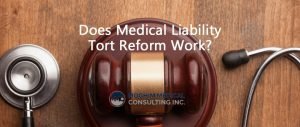 Medical liability tort reform is an ever-present issue that is often at the heart of any serious health care reform debate. Both sides have compelling arguments. Health care providers are often shackled by fears of frivolous malpractice suits leading to costly and, often, unnecessary defensive care. Patients and legal professionals, however, argue that without some form of legal recourse, physician misfeasance would go unchecked.
Medical liability tort reform is an ever-present issue that is often at the heart of any serious health care reform debate. Both sides have compelling arguments. Health care providers are often shackled by fears of frivolous malpractice suits leading to costly and, often, unnecessary defensive care. Patients and legal professionals, however, argue that without some form of legal recourse, physician misfeasance would go unchecked.
To really understand the issue of medical liability tort reform, one must look a little deeper into the structure of American health care. In our system, the vast majority of practicing physicians have malpractice insurance which pays some or all of the judgment for a malpractice claim. In 2015, the U.S. paid out $3.89 billion for malpractice claims, almost all of which came from insurers. This is indicative of a slight climb in payout totals from a record low in 2012 of $3.7 billion.
Given the enormous sums involved, it is not surprising that the real drivers of tort reform in the U.S. are insurers, not health care providers. It is primarily insurance lobbyists that have prodded the majority of state legislatures to pass laws that cap damages on malpractice claims or force claimants to utilize administrative alternatives to litigation.
In response to the growing number of tort reform states, the number of claims has declined, but the average payout has grown considerably. Between 1992 and 2014, the number of paid malpractice claims fell 56 percent. This suggests that lawyers are applying more rigorous standards to what malpractice cases they are willing to litigate in the face of tougher malpractice regimes.
However, the amount awarded in the cases that are successful has more than compensated for the fewer claims. The average payout from 1992-1996 was $287,000, but this jumped to $353,000 for 2008-2014, a 23 percent increase. Legal analysts suggest that the claims that do make it to the settlement or verdict stage are typically stronger, yielding bigger awards.
The mixed verdict on tort reform is even more confusing when we examine the effect on medical methodologies. One of the principal benefits of tort reform was supposed to be less defensive medicine, ultimately lowering the cost of health care. However, in a study of three states—Texas, South Carolina and Georgia—that passed laws making it nearly impossible to sue ER physicians, most ER practitioners didn’t vary their practices after tort reform was passed. The study found almost the same number of MRI’s and CAT scans in the tort reform states as in non-tort reform states.
In one important regard, however, tort reform has proven successful. Malpractice insurance premiums have slowed their upward climb in states where reform has been enacted; on average, premium hikes have lagged 6 to 13 percent behind non-reform states. This is primarily a result of record profits among malpractice insurers. Compared to property insurers who experience profitability of 12.5 percent, malpractice carriers have an average return of 15.6 percent. The loss ratio of number of claims to premiums has hit a milestone low of 61.1 percent.
Written by:
Dr. Robert Moghim, CEO Moghim Medical Consulting Inc.
